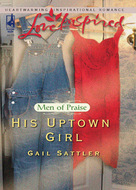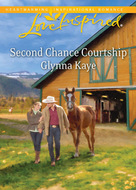This book cannot be downloaded as a file but can be read in our app or online on the website.
Read the book: «A Match Made in Dry Creek»
For a second, as Doris June stood in the doorway, framed in the light, her face showed clearly.
Curt had not realized that he hadn’t really seen Doris June since she’d been home. If he had thought about it, he would have assumed her face would have softened over the years with wrinkles and the slight paleness that comes from getting older. He would have been wrong.
She did not glow like the young girl she used to be, but she had a confidence that made her seem even more alive. She was beautiful.
Last night he thought he knew who she was in her conservative pantsuit and sensible shoes. But the vision before him made him forget all his assumptions. He’d been ten kinds of a fool to have spent the day thinking to mend Doris June’s broken heart. She’d obviously mended that heart of hers and moved on past him. For all he knew, she didn’t even remember that years ago they had packed their bags and headed out for an elopement.
JANET TRONSTAD
grew up on a small farm in central Montana. One of her favorite things to do was to visit her grandfather’s bookshelves, where he had a large collection of Zane Grey novels. She’s always loved a good story.
Today, Janet lives in Pasadena, California, where she is a full-time writer. In addition to writing novels, she researches and writes nonfiction magazine articles.
A Match Made in Dry Creek
Janet Tronstad

Honor thy father and thy mother, that thy days may be long upon the land which the Lord thy God giveth thee.
—Exodus 20:12
Dedicated with love to my younger sister, Doris, who shares her name with Mrs. Hargrove’s daughter, but who is her own person. If there is any resemblance in character between my Doris and Mrs. Hargrove’s daughter, other than the name and the faith they both share, it is coincidental.
Of course, I have no objection if my Doris were to meet her Curt and have a happily ever after, but that will be her own story.
Dear Reader,
When I picture Dry Creek, I often also picture my hometown of Fort Shaw, Montana. I particularly thought of the church in Fort Shaw when I wrote about the Mother’s Day tradition of giving pansies to all the mothers in the church. This is a tradition that has been upheld in the Fort Shaw church for decades—thanks, in particular, to the efforts of a longtime church member, Norma Olsen.
Norma, like Mrs. Hargrove, decided long ago that mothers need a thank-you, and for years she has supplied the church with enough pansies so that each mother attending receives one. As a child, I remember the pansies being passed out in church and my mother later planting hers in a flower bed beside the house. I know how special these flowers were to the women in the church back then and still are today.
I hope there is someone like Norma in your home church who helps you honor the mothers around you. If not, maybe you could be that person. It’s good that we spend one day remembering how important mothers are to our world. I hope that, in some small way, this book will be a reminder to us all of the value of the mothers in our churches.
If you are a mother, have a happy Mother’s Day this year. If your mother is not living, adopt a mother for the day and wish her a happy Mother’s Day. May we all be blessed as we do this.
Sincerely yours,

Contents
Chapter One
Chapter Two
Chapter Three
Chapter Four
Chapter Five
Chapter Six
Chapter Seven
Chapter Eight
Chapter Nine
Chapter Ten
Chapter Eleven
Chapter Twelve
Chapter Thirteen
Chapter Fourteen
Chapter Fifteen
Chapter Sixteen
Questions for Discussion
Chapter One
Winter and guilt didn’t go well together in Dry Creek, Montana. Not even for Mrs. Hargrove, who, after decades of living in the small town, was used to the icy snow that sometimes trapped a person alone inside her house for days with only her own thoughts for company.
Mrs. Hargrove had lived her life with few regrets, so she generally spent the snowy days peacefully chopping vegetables for soup or putting together thousand-piece puzzles. This past winter she hadn’t been able to do either of those things, however. Her conscience was troubling her, and she lacked the focus needed to figure out a puzzle or decide what to put into a pot of soup.
Instead, she sat and stared at the pictures on the mantel over her fireplace. There was the picture of her and her late husband, taken on their wedding day. And then there was a picture of her daughter, Doris June, taken when she graduated from high school. It wasn’t a particularly good picture because, even though Doris June was smiling, she had a certain stiffness in her face that Mrs. Hargrove hadn’t noticed until recently.
The graduation picture had been a last-minute idea and had been taken in a department store instead of at the high school like the pictures of the other students. Doris June hadn’t seemed to care about a picture, but Mrs. Hargrove had wanted one even though, for years now, she had expected to exchange that graduation picture for a glowing picture of Doris June on her wedding day.
The wedding picture was going to be the real picture on the mantel place. It was what Mrs. Hargrove was waiting for.
But that wedding day never came. This winter, as she sat on her sofa looking at the picture she did have, Mrs. Hargrove finally accepted the truth. Doris June was not going to get married. The one huge miscalculation Mrs. Hargrove had made in her life had come back to haunt her and she couldn’t stop fretting about it. She had unknowingly pushed away the only man Doris June had ever loved. For years, Mrs. Hargrove had hoped God would take care of everything in His own time, but He had not.
It had all come crashing back into Mrs. Hargrove’s awareness in early January when she and Charley Nelson had sat down at her kitchen table to begin writing a history of their small town. The two of them were the oldest of the two hundred some residents of Dry Creek, and, when the state tourism board asked the town to write a section for an upcoming guidebook, everyone said she and Charley were the natural ones to write it. Both of them agreed to do the work, thinking it would be a good way for them to pass the cold winter months pleasantly.
It didn’t take them long to realize what kind of trouble they were in, however. They knew it as soon as they opened the large white envelope the state tourism board had sent in care of the local café. Mrs. Hargrove and Charley had not known until then that the guidebook was being called Stop at One-Stop-Sign Towns in Southern Montana. Each town was supposed to begin their two pages of history and visitor attractions with an opening paragraph telling what made their particular old red stop sign unique.
It was a clever advertising idea and the state had invited several high schools in the area to help them with the tourism guide so the whole thing was a worthy project. Some art students were even going to take pictures of the signs and make a collage. Mrs. Hargrove and Charley were both one-hundred percent in favor of anything that helped students learn.
However, the stop sign in Dry Creek was the last thing either one of them wanted to write about.
Mrs. Hargrove wished people would just forget about that old sign.
Dry Creek’s one stop sign was at the south end of town next to the Enger home place. Twenty-five years ago two local teenagers had hit the sign with an old blue pickup truck as they were beginning their elopement to Las Vegas. The passenger side of the truck had bent the signpost until it looked like the smashed half of a valentine. Both being responsible individuals, the teens had reported the damage to the sheriff who then called their parents. From there, everything spun out of control until eventually the eloping couple were torn apart.
No one knew whether it was because of the broken-heart shape of the sign or the gossip about the two thwarted teens, but the story of the stop sign was told and retold until it became as close to a legend as anything Dry Creek had. A local musician even wrote a song about the heart sign and it played on the radio for a while so that people here and there throughout the state knew the story.
To this day, people would periodically place fresh flowers at the base of the rusted sign or carve their initials on the bent post. Every once in a while, there was talk of fixing the sign or even just pulling it down since the intersection it guarded was scarcely used any longer. But no one in an official capacity seemed able to make a decision to disturb the sign after its crooked form became part of the history of Dry Creek.
Charley had his elbows on Mrs. Hargrove’s worn oak table and his right hand was curled around a cup of her fine brewed coffee. “You would have thought someone died when that sign was hit.”
The contents of the envelope were sitting in front of him on the table. It was dusk and enough light was coming in the windows of Mrs. Hargrove’s dining room that she hadn’t turned on the overhead light yet.
“Sometimes a tragedy of the heart stays with people longer than a death,” Mrs. Hargrove said after a moment or two. She didn’t even notice that the light was fading. Her voice sounded tired to her own ears. “Look at Romeo and Juliet.”
Charley grunted. “It was the parents in that one, too. Everybody always blames the parents for not understanding.”
The two sat in silence as the room got a little darker.
Finally, Mrs. Hargrove said. “Well, we understood. We didn’t approve, but we knew what was what. And, at least we never tried to cover it up or anything. It was all out in the open. Everyone who was here twenty-five years ago knew it was Doris June and Curt who hit that sign. At least, we’ve never denied anything.”
Curt was Charley’s son. He was the one driving the pickup when it hit the sign as he was eloping to Las Vegas with Doris June.
Mrs. Hargrove looked down at her coffee cup. “If things had turned out differently, the story of them and that sign would be a funny family story—just the kind of thing we’d laugh about as we bounced our grandbabies on our knees.” Mrs. Hargrove stopped to sigh. She had no grandchildren. Still, she had a daughter who needed her. “As it is, I doubt either Curt or Doris June would like to see a reminder of that day in print anywhere and I’m not sure I have the stomach for it, either.”
“If only they hadn’t been so responsible and gone to the sheriff about the sign,” Charley said. “We raised those kids to have values, and that’s why it happened the way it did.”
“Doris June always did tell the truth.”
“Curt, too,” Charley paused. “Of course, we couldn’t let them get married once we knew what they were planning. Not at their ages.”
Mrs. Hargrove lifted her cup of coffee and took a sip. “Who would think a little stop sign could change so many lives?”
Charley nodded. “It broke my son’s heart.”
Mrs. Hargrove looked up from her coffee cup at that. “It didn’t break it so bad he didn’t marry that New York woman the first chance he got.”
“She wasn’t from New York,” Charley protested. “It was Chicago. And he didn’t marry her until after he spent those four years in the army.”
Mrs. Hargrove waved away the discrepancy. “All I know is she wasn’t from here and she kept Curt away from here. He should have been here beside you running your farm all those years instead of waiting until you decided to retire. Besides, Doris June, at least, showed her affections were sincere. She might have just turned seventeen, but she always did understand loyalty. She wasn’t off marrying someone else. Once she made up her mind, she kept it made up.”
“Some folks call that being inflexible.”
“And some call it being solid and reliable.”
“Well, whatever they call it, I didn’t notice you giving Doris June and Curt your blessing on that day, either,” Charley said. “It wasn’t only the Nelson family that was up in arms.”
Mrs. Hargrove nodded. He was right. “What else could we do? Doris June had just turned seventeen. I wanted her to go to college and have a chance at the world. You know I didn’t object to Curt himself, it was just the timing of things.”
“Yeah, me, too. I loved Doris June like the daughter I never had. But I thought I was being a good parent. What did two seventeen-year-old kids know about getting married?”
“They were just too young,” Mrs. Hargrove said, and Charley nodded.
They spent the next five minutes drinking their coffee and trying to think of something else they could use to show the tourism board that Dry Creek was an exciting town worthy of visitors.
“Who wants to look at an old stop sign anyway?” Charley finally said.
Mrs. Hargrove nodded. “It’s too bad I’m not still planting the field of pansies every spring. There’s a place in southern California that charges people to look at its field of flowers—ranunculus, I think—we could have the same sort of thing here for free. Maybe I should just plant the field like I used to. That would give something for tourists to see.”
“You mean the field in back of your farm?” Charley asked with a frown. Mrs. Hargrove lived year-round in her house in Dry Creek these days and no longer spent the summers on the farm she’d worked with her late husband. “You leased that land to Curt, remember? I think he wants to plow it up this spring and plant it with wheat. I don’t think he’d like people tramping through his wheat.”
“It’s the hillside on the edge of the field that I’d use. It’s too steep for wheat. You’d never get a combine in to harvest a crop. Besides, I was only saying if. If doesn’t mean when.”
The two of them stopped to drink a little more coffee and think. Mrs. Hargrove finally noticed how dim it was and stood up to pull the chain on the light over the table.
Charley grunted in appreciation of the light. “Those pansies of yours were always something.”
Mrs. Hargrove used to love to plant her field of pansies in the early spring. It had been a tradition in the Dry Creek church for the past forty years to give out pansies to the local mothers on Mother’s Day. When the church started giving out the pansies, Mrs. Hargrove grew all of the flowers. Now her arthritis bothered her and she had given up raising the flowers ten years ago when she had stopped moving to the farm for the summers. No one else in Dry Creek had volunteered to do the planting, so the church bought tiny blooming pansies in paper cups from some store near Billings.
It was a poor substitute in Mrs. Hargrove’s opinion. “A flower should be grown with love—and big enough to see. Those paper cup ones are puny. A wind would blow them over.”
“Still, we can’t stop giving out the pansies,” Charley said. “It’s thankless enough to be a mother, we can’t take away their pansies. I remember when my wife used to get one of your pansies. She would talk about where to plant that thing for days before she actually got it. She had me digging holes all over the place.”
“Not many towns give out pansies to every single mother who shows up in church. Now, that’s tradition for you,” Mrs. Hargrove said with satisfaction. “It could also be an attraction for visitors if we had a flower field. Folks love to look at flowers.”
Charley grunted. “There might even be a picture in something like that. The guidebook people said they’d like a picture for the students to use.”
“Maybe if we focus on the pansies, that tourist board will forget about our stop sign,” Mrs. Hargrove said. “After all, the sign is all rusted out. It would make a terrible picture. It’s a wonder the thing hasn’t fallen down by now.”
Charley nodded. “It would be a blessing if it did. I think it would fall down if folks stopped piling rocks around the bottom of it.”
Neither one of them said much more. Mrs. Hargrove offered Charley some oatmeal-raisin cookies to go with his coffee and he only ate two, explaining his appetite just wasn’t with him. Mrs. Hargrove said she understood.
The information for the guidebook wasn’t due until June, so Mrs. Hargrove and Charley decided to let the matter rest for a while.
Over the next couple of months, Mrs. Hargrove’s mind kept going back to the fateful day when the Nelsons and the Hargroves had forbade their children to marry.
Mrs. Hargrove knew she and her late husband had had good intentions just like the Nelsons had. Mrs. Hargrove had thought she was doing the best thing by sending Doris June off to Anchorage to live with her aunt and refusing to give Curt the address when he asked for it.
Mrs. Hargrove had no idea Doris June would never marry and that Curt would get so angry at his folks for interfering that he’d sign up with the army just to leave home and later make a disaster of the one marriage he entered into.
As the winter wore on, Mrs. Hargrove and Charley felt so miserable about the mess they’d made of things all those years ago that they could barely face each other. Mrs. Hargrove lost her appetite and stopped cooking for herself. Every once in a while, she would open a can of soup without even checking the label, but that seemed to be all she could do. Charley missed the cookies Mrs. Hargrove used to make for him. Finally, they both knew something had to be done to set things right again before they wasted away.
“If we could unmatch them back then, we should be able to match them up again now,” Charley finally said one morning after church. He and Mrs. Hargrove were putting the hymnals back in place, so they were the only ones left in the main part of the church.
“It won’t be that easy.” Mrs. Hargrove didn’t need to ask who Charley was talking about and she felt relieved that he had finally suggested they do something. She’d been praying about the situation, but she hadn’t gotten any ideas about anything solid that she could do.
“It might be easier than we think to get them together. It’s not like either one of them is seeing someone else,” Charley said. “And they’re not shy.”
Mrs. Hargrove stopped moving hymnals and thought a minute. “It’s not a matter of shyness. We’d have to get them in the same place at the same time. That’d be the challenge. I’ve never seen two people more determined to avoid each other. Doris June won’t even visit me unless it’s the middle of summer or harvest season when she knows Curt is too busy to come into town.”
“I don’t think they’ve even talked to each other in all these years,” Charley said.
“Well, certainly not while Curt was married to that woman. Doris June was furious.”
“Did she say that?”
“She didn’t have to. I know my daughter.”
“Well, she doesn’t need to worry about the woman Curt married. She ran off with some man the day after she put Ben in kindergarten. The only time Curt heard from her after that was when he got the divorce papers. You’d think she’d at least contact her own son over the years, but she hasn’t and here Ben just turned fifteen last month. A boy like that needs a mother.”
Mrs. Hargrove bent to straighten another hymnal. She wouldn’t say it, but she knew Ben needed a grandmother, too. “He’s a good boy. I’m sure Doris June would like to get to know him better. I don’t know what would make her agree to be in the same room with Curt, though.”
Charley thought a minute. “One of us could pretend we were dying. They’d both come to see us then.”
Mrs. Hargrove stood still and thought a moment. She almost wished she could do it, but she knew better. “Nothing good ever comes of telling a lie.”
“Well, maybe we don’t need to be dying,” Charley conceded as he rubbed his chin in thought. “But we could still need some help—after all, we’re both in our seventies. That should be reason enough to give us some help if we needed it.”
Mrs. Hargrove started going down another row of pews. “I’ll not be asking Doris June for money. She already tries to give me more than she should.”
“No, money won’t work. Besides, it’s too easy to write a check. She wouldn’t even need to come home to do that.”
Mrs. Hargrove picked a hymnal up off a pew. “But what else do we need help with except money?”
Charley thought a moment. “Lifting. What we need to do is find something that needs lifting.”
“Doris June will just tell me to save the lifting until she comes in the fall.”
“Well, maybe it’s something that needs to be lifted before fall gets here.”
“The pansies,” Mrs. Hargrove said with a smile. “If I get some seeds in the ground soon, we’d have them by May.”
“A pansy’s not very heavy,” Charley said skeptically.
“They will be if we do pansy baskets this year,” Mrs. Hargrove said. Her eyes started to shine with excitement. “I saw some gardening show on television a few months ago and it showed these big beautiful pansy baskets. I thought at the time how impressed everyone would be if we could hand out baskets like that for Mother’s Day. And it’s not just the baskets. If we grow the pansies from seed there will be lots of heavy work. There’ll be bending and lifting—and digging. Besides, the pansies could be a tourist attraction, too.”
“Maybe so. That hillside used to be something to see when you grew the pansies in the past,” Charley said. “My wife used to call it a carpet of lavender. Pure poetry it was.”
“There’s nothing like the color of a pansy,” Mrs. Hargrove agreed. She was pleased Charley had noticed her flowers. Not all men did. “To fill up those big baskets, I’ll need to plant even more pansies than I used to plant. And the week before Mother’s Day, we’ll need to dig up hundreds of pansies and put them into baskets. Lots of dirt and shoveling. And me with my arthritis. How can Doris June not come?”
“And Curt would never let you do that kind of work, regardless of whether or not Doris June comes,” Charley agreed with a slow smile. “Of course, if she does come, they’ll have to see each other. A person can’t dig in a flower bed next to someone and not say hello. You know, this just might work—if Doris June comes.”
Mrs. Hargrove grinned. “Oh, she’ll come.”
“Won’t Doris ask why Curt doesn’t just do all the baskets for you? She knows he’s back on the farm.”
Mrs. Hargrove shook her head. “Oh, no, she’d have to mention his name to ask and she never does that—not even if I mention it first.”
Charley frowned. “You mean she’s never asked about him?”
Mrs. Hargrove shook her head. “Not even before he got married.”
Charley looked even more troubled. “Maybe that means she’s not interested in him. It was a long time ago.”
Mrs. Hargrove was silent for a minute. “Well, we don’t know if Curt is still interested, either.”
“He might not admit it, but he’s interested,” Charley said. “Ever since he moved to the farm three years ago, I’ve noticed that the month of June is torn right off the kitchen calendar every year—before the month even starts it’s gone.”
“Curt was the only one who used to call Doris June just plain June,” Mrs. Hargrove said. “Remember, he called her his June bug.”
“I’d forgotten about that,” Charley said. “He must have been six or seven when he started calling her that. He used to love to tease his June bug.”
“I think they might have always loved each other,” Mrs. Hargrove said. “And if Curt is still worried about a word on a calendar, there’s hope.”
Mrs. Hargrove smiled. It was time to plant her pansies. She’d wait until the seeds were sprouted to ask Doris June to come help her. She didn’t want her daughter to fret about this trip for any longer than necessary, and fret she would, especially when she realized that the pansies were being grown on land Curt was now leasing.
In the meantime, there were things to do.
It wouldn’t hurt for Doris June to do some shopping before she came. Of course, she’d never go shopping for herself if her mother suggested it. No, Mrs. Hargrove decided, the only thing to do was to ask Doris June to go shopping for something for her mother.
Doris June would love that. She had never liked the gingham housedresses that Mrs. Hargrove usually wore. Of course, the housedresses were perfectly fine. They were easy to wash and most of them had a zipper in the front so Mrs. Hargrove didn’t need to fumble with buttons when her arthritis was acting up.
Besides, in Mrs. Hargrove’s opinion, Doris June had no right to complain about the fashion of others, not when all she ever seemed to wear were business suits. It was a frustration to a mother when she had a daughter as beautiful as Doris June, who seemed determined to hide that fact from everyone.
To begin with, Doris June had good bones and good posture. She stood tall and confident. Her hair was a honey-blond and she didn’t make the mistake of bleaching it lighter, hoping it would become that Hollywood blond that actresses seemed to favor. Doris June’s skin was clear and her blue eyes looked straight ahead at life. She didn’t wear much makeup, but she didn’t need to.
Doris June was a classically featured woman. Sometimes, though, Mrs. Hargrove worried that her daughter didn’t look as young as she should. Before all of that elopement business, Doris June had looked like every other teenage girl. She’d bounced. She’d chattered. She’d even worn some kind of bright blue fingernail polish at the time. But after the elopement—well, Doris June just didn’t seem the same. She stiffened up.
She walked instead of bouncing. She was patient and long-suffering. Mrs. Hargrove couldn’t help but notice that her daughter had started to dress like an old lady. Not that she wore housedresses like Mrs. Hargrove did. She would never do that. But Doris June stopped wearing anything that seemed youthful. She still had all the looks she needed to grab the attention of any man she wanted. It’s just that, once she had their attention, they were more likely to think of her as a good neighbor or a good employer than a romantic partner.
Mrs. Hargrove decided it was too late to worry about the bouncing. At forty-two, Doris June would have outgrown that by now anyway. But Mrs. Hargrove figured she could do something about the suits Doris June always wore. She had suits in black, gray, and navy, and she wore them with white blouses. She always looked crisp, but even Mrs. Hargrove knew clothes like that encouraged a man to think of a tax audit rather than a candlelight dinner.
Mrs. Hargrove felt too guilty to ever talk to Doris June about the kind of clothes she wore, but a mother noticed certain things even if she didn’t know what to do about them. Maybe she could do something now, though, if she had Doris June go shopping for her. If she wanted to get Doris June to buy some new clothes for herself, she had to get her into different stores than the ones where she usually shopped, so she wouldn’t ask her to buy more gingham dresses. No, she’d ask Doris June to get her a spring dress or two that had some style.
While she was there, Doris June might even pick up some high heels for herself. It wouldn’t hurt to remind Curt that Doris June had nice legs.
Yes, Mrs. Hargrove thought, this just might work.
The free sample has ended.








